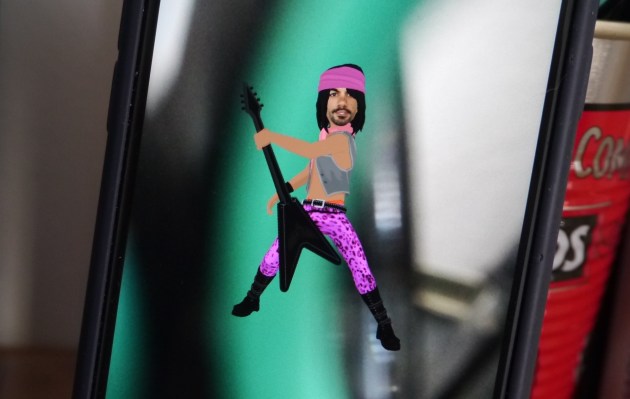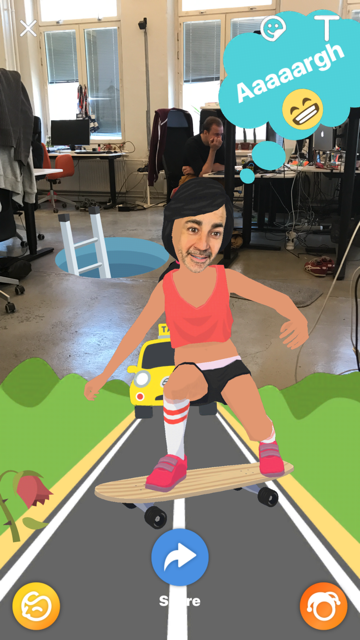Move over duckface. Shove off rainbow spew. There’s a new selfie game in town and it wants to turn your 2D visage into uncannily accurate 3D — then splice that axiomatic piece of you into animated cartoon suits that rock out, strut their disco stuff, skateboard, look coy, relaxed or laugh maniacally.
Think: realistic-looking stickers that twist and twirl. If that idea doesn’t immediately thunder with resonating intent through your mental social feeds this app is definitely not for you. It’s definitely not for me — but selfie is as selfie does. And those that selfie rarely stop. They just need new twists to keep upping their gaze-game.
And so we arrive at Miso Happy. Terrible name, terribly creepy results… Expect this 3D selfie maker app to either have you shrieking with delight — or plunged deep into the uncanny valley reaching for the ‘delete face’ button with a horrified expression on said face.
The Finland-based startup behind the app, Futurefly, pitched it to TC as an “augmented reality sticker faceapp“. Which is a little linguistically hacked together but did get the message across. On the App Store it’s billed as “your 3D selfie effect”.
The app’s (word-punning) name suggests the team reckons it will do well in Japan. As does the fact one of the first clutch of cartoon suits is described as a “shy Anime schoolgirl”. There’s also a sumo wrestler suit, along with a skater kid, a snowboarder, the above pictured glam rocker, a disco dancer, an angel, a couple of exhausted looking beach bums, and more.
Miso Happy is AR because once you’ve snapped a photo and generated your creepily realistic (‘uhhh, that really is my face licking that guitar… O___o ‘) 3D selfie, and dressed it in the animated suit of your choice, it then appears doing its routine in the camera view — waiting to be video overlaid against the real world backdrop of your choice.
You can also add text and emoji overlays to your composition, pinching to zoom any other elements up or down in size as you like.
Then, once you’re content with your content it can be shared to social feeds like WhatsApp and Facebook as a video (or a GIF), or saved locally on your iPhone if you don’t want to immediately spam your social graph with all your 3D action selfies.
There’s a pretty small selection of cartoon body suits to choose from at this launch point, but the team says it will “regularly” be adding new ones, and that there will be no need to update the app to get them. This is also Futurefly’s monetization route — with the plan being to offer twelve free 3D animated stickers per day, plus three locked stickers which can be unlocked by watching one video ad.
The app also lets you store different selfies, so you can keep a library of friends’ selfie ‘face masks’ to play around with. Assuming that’s the kind of friend you are.
Computer vision
What’s the core technology here? Computer vision of course — a very hot area for tech activity (and acquisitions) these days. For example Snapchat snapped up another European startup offering 3D selfies (Seene) last year. (Likely feeding some of that tech into its World Lenses launch, which lets its users add AR 3D objects to their Snaps.)
“The core face reconstruction technology combines computer vision and computer graphics to get the final results,” says Oskari Häkkinen, founder & chief product officer at Futurefly, explaining how Miso Happy achieves its uncanny 3D effects (and pictured below putting his own face through the process). “We use landmark detection to detect the eyes, mouth, nose and the contour of the face. This is the same technology which is used in apps like Snapchat and Facebook Messenger when applying face filters.”
This translates in app to a marked face template at the point of selfie taking which encourages the user to correctly position their face within the guide lines. They also suggest using a white/light background for best results.
“After the user snaps their selfie with Miso Happy, we approximate the camera angle and fit the users landmark data into a generic face morphable model, which returns us the 3D vertices. Next we project the selfie pixels into a texture map and onto the 3D model. Finally we post-process the texture illumination and remove any strong specularities,” he adds.
Häkkinen says the tech was challenging to develop, although from the user point of view it’s disturbingly quick and easy to turn a selfie into facial 3D. The processing is done locally on the device to ensure there’s as little delay as possible while you wait for your selfie to be reformed into digital 3D. The app is optimized for iPhone 5 and above and iOS version 8.1. (An Android version is scheduled for later this year.)
Another challenge during development was creating a realistic enough 3D likeness that users wanted to share the results.
“We had our initial implementation of the technology in September last year, which we tested with college students. At first, they were stoked, laughed a lot and said it was awesome. However, when it came to sharing they actually didn’t want to share it with friends because it didn’t look enough like them,” Häkkinen tells TechCrunch.
“At the time the method we were using was to project a texture onto a morphable avatar that users had to morph themselves. But after time we realized that people actually don’t know the exact shape of their faces, and therefore couldn’t really morph the avatar accurately enough to be left satisfied with the results. With that, we knew we had to automate that process, else users would always feel the results were ‘slightly off’. The new tech has an automated morphable face model that adjusts with the retrieved face data.”
So while the results are still uncanny valley levels of creepy IMO, clearly they were a lot MOAR uncanny before.
The team is also working on adding further post-processing features such as “beautify filters”, according to Häkkinen. And is developing augmented reality surface detection to enable the 3D characters to “snap to different surfaces within the world”. At the moment the animated figures just float in the middle of the screen or wherever you generally position them.
Who and/or what is Miso Happy for? Clearly it’s just for fun, and aimed squarely at Generation Snap/selfie. The team’s longer term gambit is perhaps to be (ho-ho!) snapped up by a larger entity that appreciates the visual expertise they are now demoing in the wild.
“We just hope people will jump on this, create fun content and tell us what kind of new animations they want. Content is pretty easy now for us deliver, and we can deliver it pretty fast and through the backend, so we hope people will come back daily to check out the new content daily,” says Häkkinen.
“For now it’s just a content creation tool, much like Snapchat and Messenger filters, but with a totally new and unique twist. I guess nobody needs faceapp to make museum paintings smile, but it’s fun as hell, so who cares, right?” he adds.
Asked whether they’d be open to acquisition approaches from the right kind of buyer, his response can be summed up as ‘definitely maybe’. “Well, it’s a mixed bag really, we love to be independent, but sometimes partnering up can help your products reach the largest possible audience, which is why we get up each morning. That said, we are currently in the process of raising our next round with the intention to grow our user base,” he says.
Futurefly, which is headquartered in Helsinki and was founded in 2014, has raised $3M to date, from private Silicon Valley investors who were early investors in Snapchat, WhatsApp, Twitter and Facebook — so it certainly has lines in to the biggest social platforms around.
Other investors include Arielle Zuckerberg, Betaworks, Broadway Video Ventures, Vision + and Risto Siilasmaa (chairman of Nokia).
This is one of a handful of apps the team has made. One of its earlier products, Rawr Messenger, which sticks 3D avatars into a messaging space, has more than a million users, according to Häkkinen. He doesn’t break out user numbers for another of its apps EatMessage, which is billed as the “first ever selfie game where you use your mouth as the controller”.
Futurefly is surely hoping Miso Happy will be the viral hit that helps it make more of a mainstream splash.


